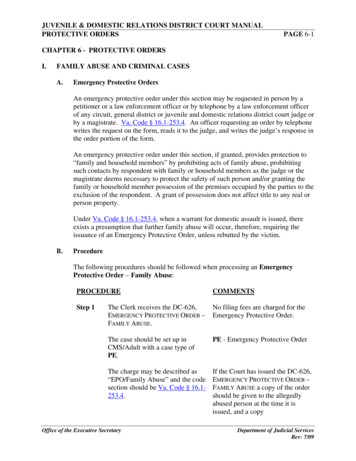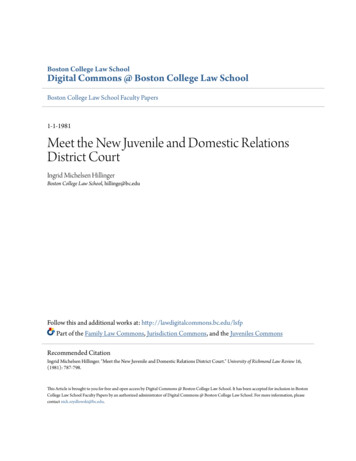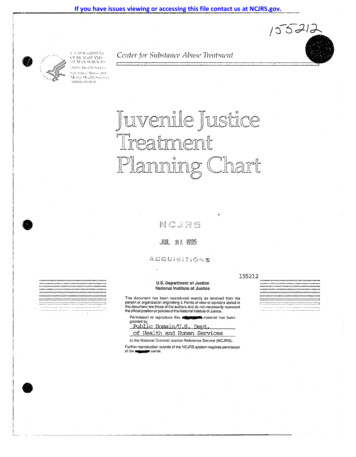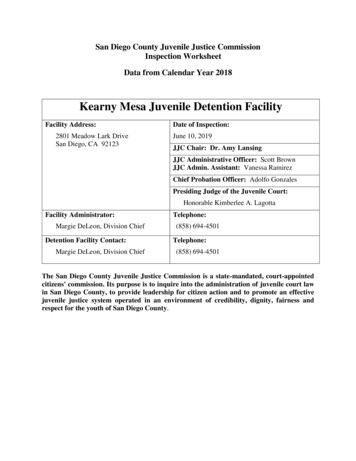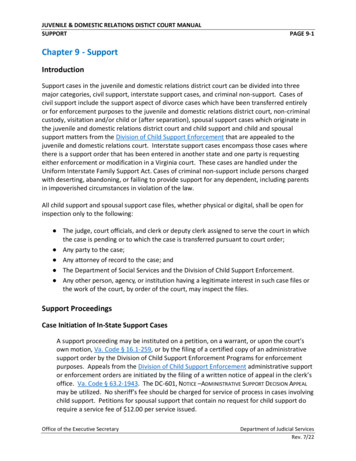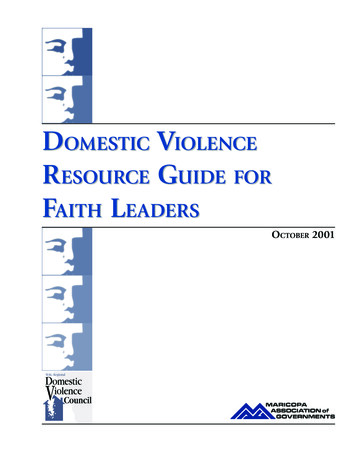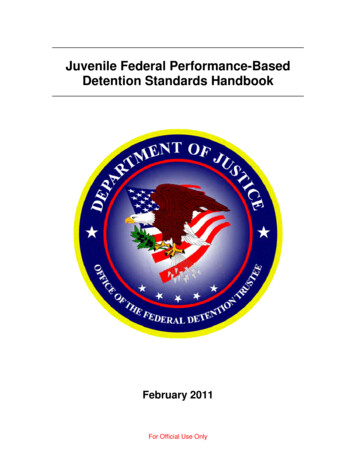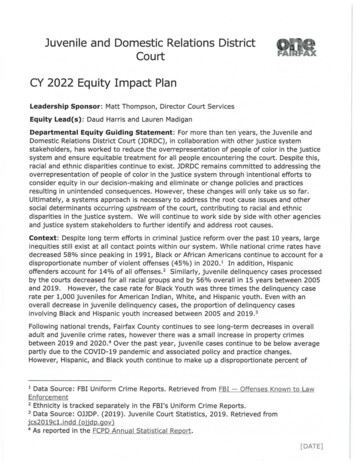
Transcription
Juvenile and Domestic Relations DistrictCourtCY 2022 Equity Impact PlanLeadership Sponsor: Matt Thompson, Director Court ServicesEquity Lead(s): Daud Harris and Lauren MadiganDepartmental Equity Guiding Statement: For more than ten years, the Juvenile andDomestic Relations District Court (JDRDC), in collaboration with other justice systemstakeholders, has worked to reduce the overrepresentation of people of color in the justicesystem and ensure equitable treatment for all people encountering the court. Despite this,racial and ethnic disparities continue to exist. JDRDC remains committed to addressing theoverrepresentation of people of color in the justice system through intentional efforts toconsider equity in our decision-making and eliminate or change policies and practicesresulting in unintended consequences. However, these changes will only take us so far.Ultimately, a systems approach is necessary to address the root cause issues and othersocial determinants occurring upstream of the court, contributing to racial and ethnicdisparities in the justice system. We will continue to work side by side with other agenciesand justice system stakeholders to further identify and address root causes.Context: Despite long term efforts in criminal justice reform over the past 10 years, largeinequities still exist at all contact points within our system. While national crime rates havedecreased 58% since peaking in 1991, Black or African Americans continue to account for adisproportionate number of violent offenses (45%) in 2020.1 In addition, Hispanicoffenders account for 14% of all offenses.2 Similarly, juvenile delinquency cases processedby the courts decreased for all racial groups and by 56% overall in 15 years between 2005and 2019. However, the case rate for Black Youth was three times the delinquency caserate per 1,000 juveniles for American Indian, White, and Hispanic youth. Even with anoverall decrease in juvenile delinquency cases, the proportion of delinquency casesinvolving Black and Hispanic youth increased between 2005 and 2019.3Following national trends, Fairfax County continues to see long-term decreases in overalladult and juvenile crime rates, however there was a small increase in property crimesbetween 2019 and 2020.4 Over the past year, juvenile cases continue to be below averagepartly due to the COVID-19 pandemic and associated policy and practice changes.However, Hispanic, and Black youth continue to make up a disproportionate percent ofData Source: FBI Uniform Crime Reports. Retrieved from FBI — Offenses Known to LawEnforcement2 Ethnicity is tracked separately in the FBI's Uniform Crime Reports.3 Data Source: OJJDP. (2019). Juvenile Court Statistics, 2019. Retrieved fromjcs2019c1.indd (obdp.gov)4 As reported in the FCPD Annual Statistical Report.1[DATE]
cases representing 27% and 10% of the youth in Fairfax compared to 49% and 28% ofjuvenile cases respectively5.A specific subset of offenses continues to be of concern among JDRDC's population.Following along with other national trends indicating an increase in drug abuse violations6,probation officers report that substance use and abuse, including the use of opioids,continues to be an issue for many JDRDC clients. Locally, in Fairfax, challenges existaccessing some court-ordered substance abuse and mental health services for adult clientswho are uninsured or underinsured and don't meet the Community Services Board's (CSB)priority population guidelines for treatment or services. Many private providers do notaccept insurance. Paying out-of-pocket for services is not always an option for someclients, especially those with less income, which disproportionally tend to be people ofcolor.Overall JDRDC has a diverse workforce, with staff of different races, ethnicities, and genderrepresented at all levels of the agency. However, we continue to recognize the importanceof our workforce being reflective of our client population. Finally, we continue to work onways to improve our recruitment, hiring, promotion, and retention of minority staff tobetter reflect the client population we serve.Long-term Outcome(s):0 Cultural and Recreational Opportunities0 Economic OpportunityN Efficient and Effective GovernmentEl Empowerment and Support forResidents Facing VulnerabilityO EnvironmentEl HealthCIO11NHousing and Neighborhood LivabilityLifelong Education and LearningMobility and TransportationSafety and SecuritySystem-Level Infrastructure:JDRDC will continue working with and collaborating with other Fairfax County agencies toidentify opportunities for earlier intervention and diversion away from formal justice systeminvolvement and reduce racial and ethnic disparities. Central to this effort is Fairfax Co.Public Schools, the police department, the Department of Family Services (DFS),Neighborhood and Community Services (NCS), and the Community Services Board (CSB).JDRDC and DFS are working together to identify dual-status youth; that is, youth involvedin the child welfare system and juvenile justice for earlier identification and intervention toprevent justice system involvement. Statistically, youth encountering the child welfaresystem are more likely to be involved with the juvenile court for delinquency. This effort isongoing with grant-funded technical assistance and support from the Robert F. KennedyNational Resource Center for Juvenile Justice.56Data source: JDRDC 2021 Annual Report. (Forthcoming).Data Source: FBI Drug Abuse Violations - Uniform Crime Reports.2
JDRDC also continues to work with the police department, NCS, and FCPS to expand accessto the Alternative Accountability Program (AAP), a community-based diversion program forfirst-time offenders. JDRDC has implemented a clearinghouse model whereby the policedepartment refers all delinquency complaints to Juvenile Intake, where they are screenedand referred to the appropriate level of intervention. By shifting centralized decisionmaking to Juvenile Intake, JDRDC has increased referrals to the AAP program and diversionopportunities for youth of color. JDRDC has also partnered with the police department totrain recruits at the Criminal Justice Academy on juvenile-justice-related topics.Addressing the issue of equitable access and availability of behavioral health and substanceabuse services for adults not meeting CSB priority population guidelines remains anongoing challenge for JDRDC. JDRDC, working with the CSB, will complete a gap analysis ofthe availability and accessibility of behavioral health and substance abuse services for adultprobation and pretrial service clients to inform next steps.The need for improved centralized coordination of activities and limitations on informationsharing are barriers to effective cross-agency collaboration and system-level responses.Where appropriate and permissible by law, JDRDC continues to work with partner agenciesto enhance communication and coordination of service delivery to shared clients.
JUVENILE AND DOMESTIC RELATIONS DISTRICT COURT CALENDAR YEAR 2022 EQUITY IMPACT PLANGoals1. Inresponse tothe ongoingepidemic ofsubstanceabuse in thecountyresulting inissues suchas opioidoverdosesthe Racialand EthnicDisparities(RED) teamwill exploretheaccessibilityandavailability ofservices toensureequitabledelivery ofservicesamongst allcountyresidentsserved byJDRDC.One FairfaxArea of FocActionStakeholdersTimelinela. Provide regular training andeducation updates to JDRDC staffon available substance abuseservices within the community.CSB, JDRDC,Children'sServices Act(CSA), VirginiaAlcohol SafetyAction ensics/CSB,JDRDC CSUJanuaryDecember2022JanuaryDecember2022Staff, time,moneyThe RED team,JDRDC CSUSeniorManagementTeam(SMT)(CSUDirector, DeputyDirector ofOperations,Deputy Directorof erJDRDCJanuaryDecember2022Staff, timeResearch,probation stafflb. Explore the possibility of aseparate substance abuse contractfor assessment/service for bothjuvenile and adults.lc. Collect data and complete agap analysis of substance abuseand mental health treatment andservices for adult probation andpretrial clientsResourcesportsStaff, timeResponsiblePa tiesRED team,: Court ServicesUnit (CSU) staffPerformancee u .eTime frame fromreferral toinception ofservice/tx; % ofclients whoreceived neededservice; A) ofclients whoreceivedtx/services atreduced rate dueto income% of juvenileclients with adecrease in Sub.Abuse domain onrisk assessment.% of clients withsubstance abuseand/or mentalhealth needs
2. Toincreasecollaborationwith statepartners to .ensureequitabilityof access.1010, 16Jan-Dec2022Staff, timeASAP/ResearchCSU, DR,Clerks OfficeJan-Dec2022Staff, timeDR, REDHumanResources(HR), essProgram(LAP), REDteamHR, SMT,HiringManagers,RED team,TrainingCoordinatorJan-Dec2022Staff, timeHR, HiringManagersJan-Dec2022Staff, time,money2d. Develop a "cheat sheet" forclerk's office for DomesticRelations (DR) intakes3a. Increase diversity of JDRDCstaff within the juvenile probationdepartment2c. VASAP Commission/Adding/collecting demographicstats on clients through ASAP3. To ensurethe JDRDCworkforcereflects the 'populationwe serve(ongoinggoal from2021 plan)RED, SMT,probationsupervisorsJan-Dec20222b. To explore gaining access toDepartment of Criminal JusticeServices (DCJS) data to expandJDRDC adult services data forfurther gap analysis3c. Expand diversity andrecruitment of JDRDC volunteers3e. Ensure interview panels reviewimplicit bias bench card togetherprior to beginning interviews.(Completed at same time as NonDisclosure Agreement - NDA).4Alcohol SafetyAction Program(ASAP)/GeneralDistrict (GD)relationship,staff, timeStaff, timeClerks'office/statepartners,JDRDC CSU,SMT and CSUsupervisorsCSU SMT,CommunityCorrections(CC),Research,DOS datateamVASAP, CSUSMT2a. Establish better lines ofcommunication with Clerks'officeand identify points of contact toanswer questions and resolvecommon issues.Jan-Dec2022Jan-Dec2022Staff, timeResearchQualitative, survey probationsupervisors and: clerks to raterelationships(outcomesimprovedcommunication.on both sides,client/communitybetter served).Volunteer/Interncoordinator LAPRED teamHR, Trainingcoordinator,RED team# of State clerksforms translatedinto top 5languages i.e.calendar controlform, motionsform, etc)Does race andgenderbreakdown ofstaff match clientpopulation? checked annuallyInterviewpanelist signdocumentindicating theycompleted thereview of benchcard prior tobeginninginterviews.
4. To applyan equitylens to bothnew andexisting31312DCpolicies,practices andprogrammingP*.Director's Signature:4a. Develop, document,communicate, and train JDRDCstaff on a process to review newand changing policies andprocedures4b. RED team to review new andchanging JDRDC policies andproceduresSMT, REDteamRED, DiversityEquity 2022Staff, timeStaff, timeSMT, RED team,Initiatives andSpecial ProjectscoordinatorRED team, DEIAmbassadors# of reviewscompleted% ofrecommendationsfollowedCompletion andapproval of newprocesski,„441-)
Departmental Equity Guiding Statement: For more than ten years, the Juvenile and Domestic Relations District Court (JDRDC), in collaboration with other justice system stakeholders, has worked to reduce the overrepresentation of people of color in the justice system and ensure equitable treatment for all people encountering the court. Despite this,

